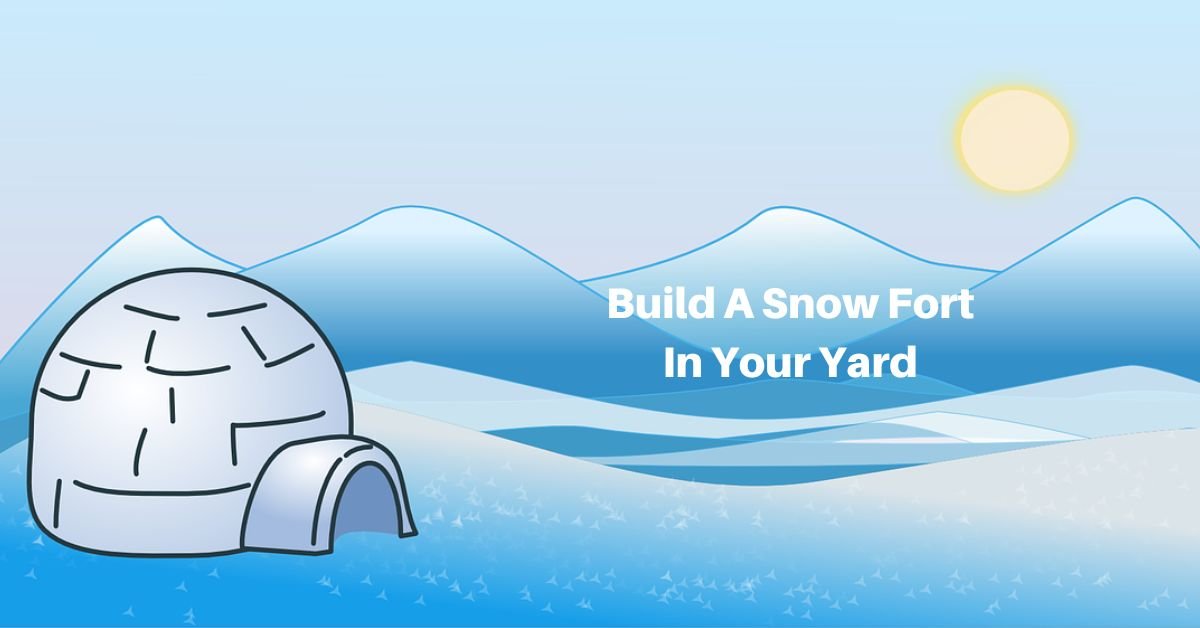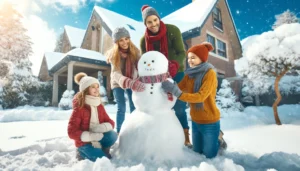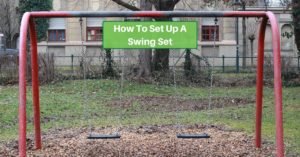Winter brings a unique kind of magic, especially for children who love to play in the snow. Building a snow fort is a timeless tradition combining creativity, teamwork, and outdoor fun. It offers a fantastic way for kids to expend their energy and encourages them to engage with the natural environment playfully and constructively.
Planning Your Snow Fort
Before you start building, some planning goes a long way in ensuring that your snow fort is safe and enjoyable.
The first step is choosing the right location. It’s crucial to pick a spot away from potential hazards, such as roads, driveways, or areas where snowplows might operate. A flat, open area in your yard or a nearby park is ideal. Make sure the location is also visible from inside the house or another vantage point where you can keep an eye on the kids while they play. This ensures their safety and your peace of mind.
Next, consider the weather and snow conditions. The best snow for building is typically slightly wet, as this type of snow sticks together well and forms sturdy blocks or walls. It may not hold its shape if the snow is too dry and powdery. But if it’s too slushy, it can be challenging to mold and might collapse easily. Check the forecast to ensure you have a good day ahead for building — ideally, with temperatures just below freezing so the snow will remain firm.
Once you have the perfect location and the right snow conditions, it’s time to gather your tools and supplies. Basic items like shovels and buckets are essential for moving and packing snow. If you want to get creative, you can also use molds or plastic storage bins to form snow bricks, which can make building faster and more fun.
Remember to dress the kids (and yourself!) in warm, waterproof clothing, including gloves and boots. This ensures everyone stays comfortable and dry throughout the activity, allowing for a more enjoyable experience.
Designing the Snow Fort
Once you have a plan, it’s time to design your snow fort!
The design phase is an excellent opportunity to get the kids involved and let their imaginations run wild. Start by discussing what kind of fort you want to build. Some kids might prefer a simple structure with high walls to defend against snowball fights. Others might dream of a more elaborate igloo-style fort or even a multi-room snow castle.
Encourage your children to sketch out their ideas on paper first. This not only helps them visualize the project but also adds an educational element as they translate their ideas into a plan. You can guide them through the basics of layout, such as where the entrance will be, how many walls are needed, and any special features they want to include. This hands-on learning experience fosters their creativity and problem-solving skills.
Of course, the goal is to have fun and be creative, so there’s no need to stick strictly to the plan once construction begins. As you build, you might find that some ideas work better in theory than in practice, and that’s okay! The process of adapting and problem-solving is part of the learning experience and adds to the excitement of the project. This flexibility allows you to tailor the fort to your children’s preferences and the available resources.
Building the Foundation and Walls
Once you have a design in mind, it’s time to start building! The foundation is the most critical part of your snow fort, providing stability and structure. Begin by marking out the perimeter of your fort using a shovel or by dragging a stick through the snow. This outline will serve as your guide as you build the walls.
To create a solid base, start by packing down the snow within the perimeter. You can use your feet, shovels, or even sleds to compact the snow. This helps prevent the fort from sinking or collapsing as you build it higher. Once you have a firm base, begin constructing the walls.
One effective method for building walls is to create snow bricks. You can use a variety of molds, such as plastic bins or buckets, to form these bricks. Fill the mold with snow, pack it tightly, and then flip it over to release the brick. Place each brick carefully, stacking them like you would with regular building blocks. Be sure to stagger the bricks, similar to how bricks are laid in a wall, to provide extra strength and stability.
Alternatively, you can use the packed snow method, which involves piling snow into a wall and shaping it with shovels or your hands. This method requires a bit more effort to ensure the wall is evenly built and stable, but it can be quicker than making individual bricks.
Whichever method you choose, make sure to pack the snow tightly and smooth out any loose or crumbly parts.
As you build, keep an eye on the height of the walls. For safety reasons, limiting the height to about three feet (around one meter) is generally a good idea, especially if younger children will be playing inside. This reduces the risk of the walls collapsing inward. If you want to build higher, consider sloping the walls inward slightly, which adds additional support.
Adding Features and Details
Once the main structure of your snow fort is complete, it’s time to add some fun features and details that will make your fort unique. Start by carving out windows and doors. Use a small shovel, trowel, or even a kitchen spatula to carefully cut openings in the walls. Don’t make them too large, though, as this could compromise the integrity of the structure.
For windows, consider creating small, strategic openings that allow light in but still maintain the fort’s strength. Doors can be slightly larger, but again, keep safety in mind. A small, arched doorway is often a good choice because it provides access without weakening the wall too much.
To make the fort even more exciting, you can add decorative elements. For example, you can use colored water to paint the walls of your fort. Mix food coloring with water in a spray bottle and let your kids decorate the fort however they like. Another fun idea is to add flags or banners to the top of the walls using sticks and fabric. This adds a playful touch but also makes the fort easier to spot from a distance.
You can also create small seating areas or benches inside the fort by packing snow into sturdy shapes. These can serve as places for the kids to sit and play or take a break from the cold. If you have extra snow, consider building a small snow table where kids can place their snacks or hot cocoa while enjoying their fort.
Playing and Enjoying the Snow Fort
Now that the snow fort is complete, it’s time to let the kids enjoy their creation!
There are countless ways to play in and around a snow fort. They can pretend to be knights defending a castle, spies hiding out in a secret base, or explorers braving the Arctic. Encourage them to use their imaginations by suggesting different scenarios or providing simple props like sticks for swords or scarves for flags.
Snowball fights, using the fort as a base, are another fun activity. Establish some ground rules to ensure everyone plays safely. For instance, you could agree that only soft snowballs are allowed and that aiming for faces is off-limits. You can also create teams and set up different areas for each group to defend.
Consider setting up a cozy nook inside the fort for quieter play where kids can sit and enjoy a winter picnic. Bring out blankets, a thermos of hot cocoa, and some snacks for a unique and memorable outdoor experience. This is also a great time to talk about the science of snow and ice, share interesting facts about how snowflakes form, or discuss the importance of winter weather.
As the days go on, you may need to make some repairs to the fort. Encourage the kids to help with maintenance, such as reinforcing walls that have started to sag or clearing out snow that has drifted inside. This keeps the fort safe and usable and teaches the children responsibility and the value of taking care of their creations.
Safety Tips and Precautions
Building and playing in a snow fort can be fun, but prioritizing safety is crucial. Here are some important safety tips and precautions to keep in mind to ensure everyone has a safe and enjoyable experience!
First and foremost, always supervise young children while they’re building or playing in the snow fort. While it’s great for kids to engage in independent play, the unpredictable nature of snow structures means that adult supervision is essential.
Keep an eye on the weather as well; conditions can change quickly, especially in winter. If temperatures rise significantly or heavy snow is expected, it may be best to pause playtime and wait for more favorable conditions.
Another important consideration is the fort’s structural integrity. Avoid building the walls too high, as tall walls are more likely to collapse. As mentioned earlier, limiting wall height to around three feet (one meter) can help prevent accidents.
Additionally, make sure the walls are thick enough to support their height. A good rule of thumb is to make the base of the wall about as wide as half the wall’s height. This ensures that the structure is stable and less likely to topple over.
Don’t make windows or doors too large. Large openings can weaken the structure, increasing the risk of collapse. Instead, opt for smaller, strategically placed openings that provide light and entry points without compromising safety.
If you’re building an igloo-style fort or any covered structure, always make sure there is adequate ventilation. This is especially important if the kids are playing inside for extended periods so that dangerous carbon dioxide doesn’t build up.
It’s also essential to teach kids about the importance of never tunneling under or through the walls of the snow fort. Tunnels can easily collapse, trapping children inside. If your kids are keen on digging tunnels, it’s better to direct them to another part of the yard where they can dig safely without risking the stability of the fort.
Make sure that all participants are dressed appropriately for the weather. Wet, cold clothing can lead to hypothermia or frostbite, so ensure everyone is wearing waterproof layers, insulated gloves, hats, and boots. Keep a set of spare gloves and hats on hand in case they get wet, and encourage kids to take breaks indoors to warm up with a hot drink.
Lastly, consider marking the snow fort with flags or brightly colored objects to make it more visible, especially if you live in an area where snowplows or snow blowers operate. This helps prevent accidental damage and ensures that everyone in the area knows the fort’s location.
Building a snow fort is a fantastic winter activity that combines fun, creativity, and physical activity. It provides an opportunity for kids to engage with nature, learn new skills, and work together to create something extraordinary. Whether you’re constructing a simple fort or a more elaborate snow castle, the process of planning, building, and playing in a snow fort is a great way to make the most of the snowy season.
Our tips and precautions can help you ensure your snow fort is safe and enjoyable. Enjoy the process — the best part of building a snow fort is the fun and memories created along the way. So bundle up, head outside, and start building your very own winter wonderland!









